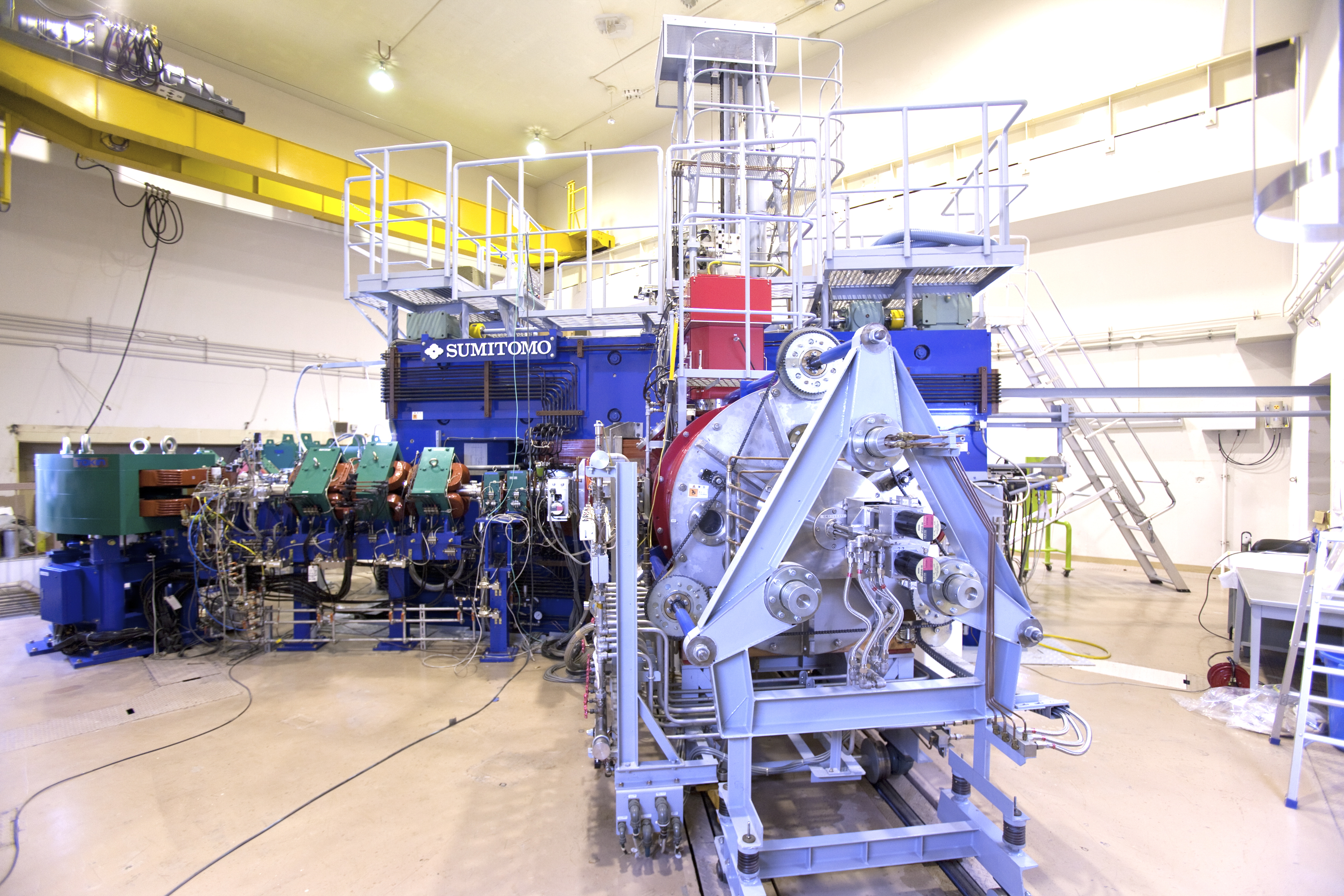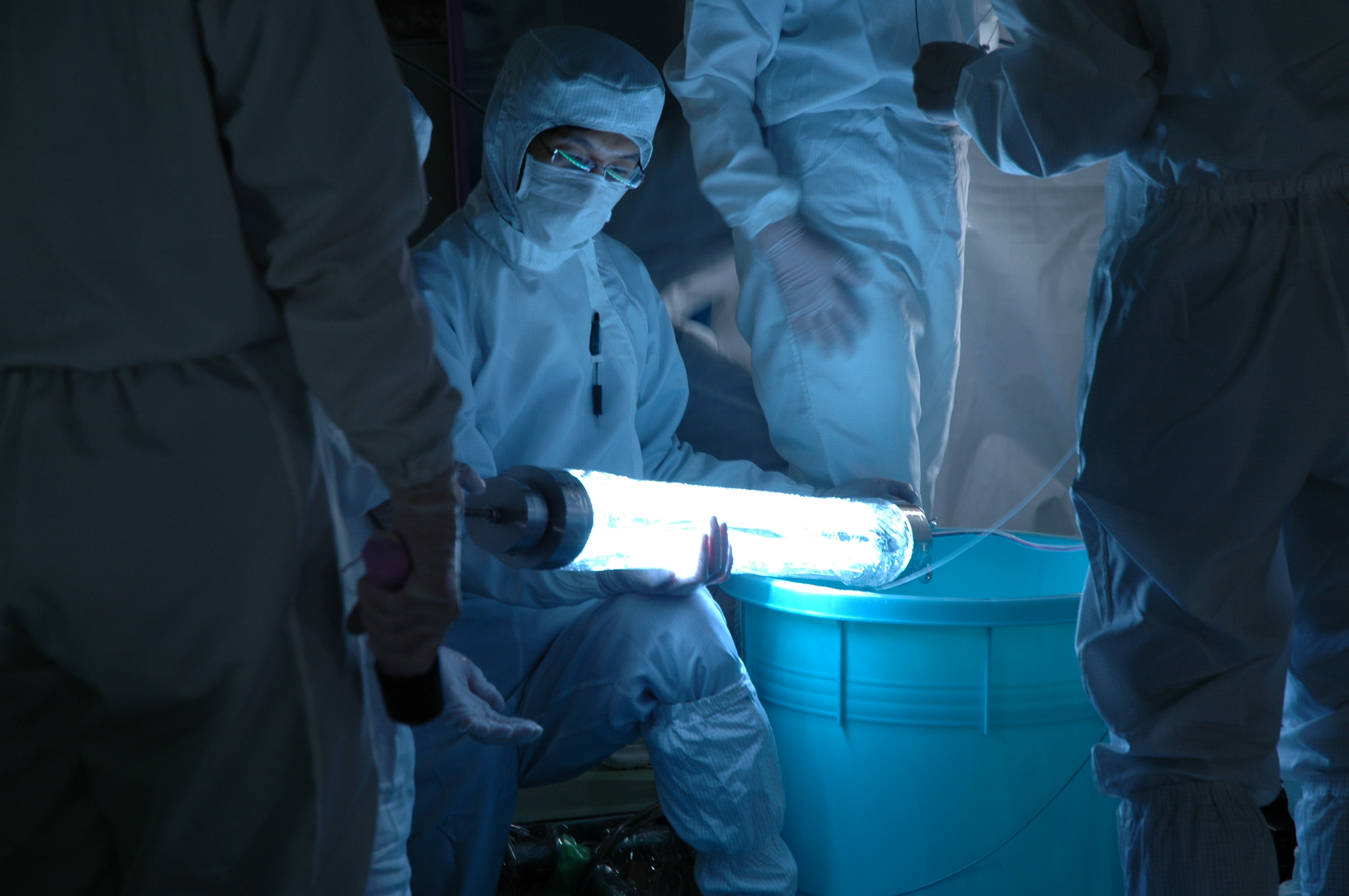Research
Research Center for Neutrino Science (RCNS)
Ordinary matter including our bodies ultimately consists of electrons and up and down quarks. A neutrino is an elementary particle categorized with these matter particles. Neutrinos are 9 to 10 orders of magnitude more abundant than the other matter particles in the universe. Their characteristics are closely related to the structure of the universe and the grand-unified theory of elementary particles. Neutrino properties are also expected to explain why our universe is made of
matter. However, neutrinos penetrate matter almost freely and they are rather difficult to detect. The RCNS reveals the properties of such elusive neutrinos using an underground-, huge-, ultra-low-background detector, i.e., the Kamioka Liquidscintillator Anti-Neutrino Detector (KamLAND). KamLAND detects anti-neutrinos from distant nuclear power plants and enables us to determine how electron-type neutrinos travel. Neutrinos currently serve as tools to enable the interiors of opaque objects to be observed. KamLAND has pioneered "Neutrino Geophysics" enabling neutrinos emanating from the earth to be observed and this is going to propel "Neutrino Astrophysics" through detecting abundant low-energy neutrinos created at the center of the sun.
A new project, KamLAND-Zen (Zero neutrino double-beta-decay search) is running in parallel. The project investigates if neutrino and anti-neutrino are identical. This feature is allowed only to neutral particles, i.e. neutrinos, and is believed to be connected with fundamental questions of the universe and elementary particles, "why does matter dominate anti-matter?", "Why does neutrino have tiny mass?". A new frontier of ultra-low radioactivity experiment propelled in KamLAND also covers various subjects including dark matter, number of generations of elementary particles, pre-supernova alarm and so on.
Research Center for Electoron Photon Science (ELPH)

Research Center for Electron Photon Science (ELPH) is a nationwide joint-use research center in nuclear science. It was founded to aim at carrying out fundamental researches and applications in nuclear science as well as at educating students and young researchers.
The ELPH facility operates two accelerators: an electron linear acceleratorand a 1.3 GeV synchrotron.
The linear accelerator provides an intense pulsed beam whose energy is typically 60 MeV, and has been used in a wide range of research fields, not only in nuclear physics but in solid state physics, radiochemistry, biology, engineering, and so on.
A GeV tagged photon beam produced with an internal radiator from a 1.3 GeV electron beam stored in the synchrotron is utilized for hadron-physics experiments.
The research program of Nuclear Science Group has four main components: the quark nuclear physics program, the exotic nuclear physics program, the accelerator science program, and the radiochemistry program.
Institute for Materials Research (IMR)
Institute of Multidisciplinary Research for Advanced Materials (IMRAM)
Cyclotron and Radioisotope Center (CYRIC)

CYRIC was established in 1977 as an institution for carrying out research studies in various field with the cyclotron and radioisotopes, and for training researchers of Tohoku University for safe treatment of radioisotopes and radiations. The first beam was extracted at the end of December 1977. The scheduled operation of the cyclotron for research studies started in July 1979. From 2001, two cyclotrons are working; the first is the multipurpose cyclotron (K=110 MeV) which is replaced from the old one (K=50 MeV) and the second is the small cyclotron (12 MeV) for the production of positron emitters of PET study.
In conformity with the aim of establishment of CYRIC, the cyclotrons have been used for studies in various fields of research, such as nuclear physics, nuclear chemistry, solid-state physics and element analysis by PIXE and activation, and for radioisotope production for use in engineering, biology and medicine. Five divisions (Division of Accelerator, Division of Instrumentations, Division of Radio-pharmaceutical Chemistry, Division of Cyclotron Nuclear Medicine and Division of Radiation Protection and Safety Control) work for maintenance, development of facilities, and for studies of their individual research fields. The divisions belong to the graduate schools of Tohoku University.
International Research Institute of Disaster Science (IRIDeS)
Having experienced the catastrophic disaster in 2011, Tohoku University has founded the International Research Institute of Disaster Science (IRIDeS). Together with collaborating organizations from many countries and with broad areas of specializations, the IRIDeS conducts world-leading research on natural disaster science and disaster mitigation. Based on the lessons from the 2011 Great East Japan (Tohoku) earthquake and tsunami disaster, IRIDeS aims to become a world centre for the study of the disasters and disaster mitigation, learning from and building upon past lessons in disaster management from Japan and around the world. Throughout, the IRIDeS will contribute to on-going recovery/reconstruction efforts in the affected areas, conducting action-oriented research, and pursuing effective disaster management to build sustainable and resilient societies, the IRIDeS innovates the past paradigm of Japan's and world's disaster management to catastrophic natural disasters, hence to become a foundation stone of disaster mitigation management and sciences.
WPI Advanced Institute for Maerials Research (AIMR)

The Advanced Institute for Materials Research (AIMR) at Tohoku University is one of nine World Premier International Research Centers Initiative (WPI) Program established with the support of the Japanese Ministry of Education, Culture, Sports, Science and Technology (MEXT) , aimed at developing world-class research bases in Japan. After its establishment in 2007, AIMR has been active in conducting research activities and creating new systems in order to become a global center for materials science. Since 2012, AIMR has also been conducting fundamental research by finding connections between materials science and mathematics. Through prediction, AIMR aims to formulate new scientific principles that can enable the development of materials. In order to ensure that the advanced materials that have been developed play a useful role in society, AIMR is also engaged in the development of devices and systems that make use of these materials. AIMR's mission is to contribute to the resolution of resource and environmental problems caused by human beings.
Research Center for Marine Biology, Graduate School of Life Sciences
The Research Center for Marine Biology was founded in July 8th, 1924 as the Asamushi Marine Biological Station, an extension of the Biological Institute of the Faculty of Science of Tohoku University in Sendai. The center is located on the small cape near the Asamushi hot spring facing the Mutsu Bay, which is the northernmost bay on Honshu-island. It is about 2km from Asamushi-onsen Station of Tohoku Main Line, JR. There are rocky-boulder shores and sand-gravel beaches in the vicinity of the center. The rich shore flora and fauna as well as plankton are affected by influences of the cold Liman Current and the warm Tsugaru Current, which flow into the Bay. Lists of common animals, which have been used for experimental purpose in the center, have been published (Hirai, E., 1963, Sci. Rep. Tohoku Univ., Ser. IV, Biol., 29, 369: Tsuchiya, M. and K. Osanai, 1978, Bull. Mar. Biol. Stn. Asamushi, Tohoku Univ., 16,29). Various sea urchins (Hemicentrotus pulcherrimus, Strongylocentrotus intermedius, S. nudus, Glyptocydaris crenularis and Temnopleurus hardwicki) and ascidans (Halocynthia roretzi, Ciona savignyi, Chelyosoma siboja and Ascidia sydneiensis samea) are available for experiments almost throughout the year. The scallop (Patinopecten yessoensis) and the ascidian (Halocynthia roretzi) are cultivated in the Bay.





